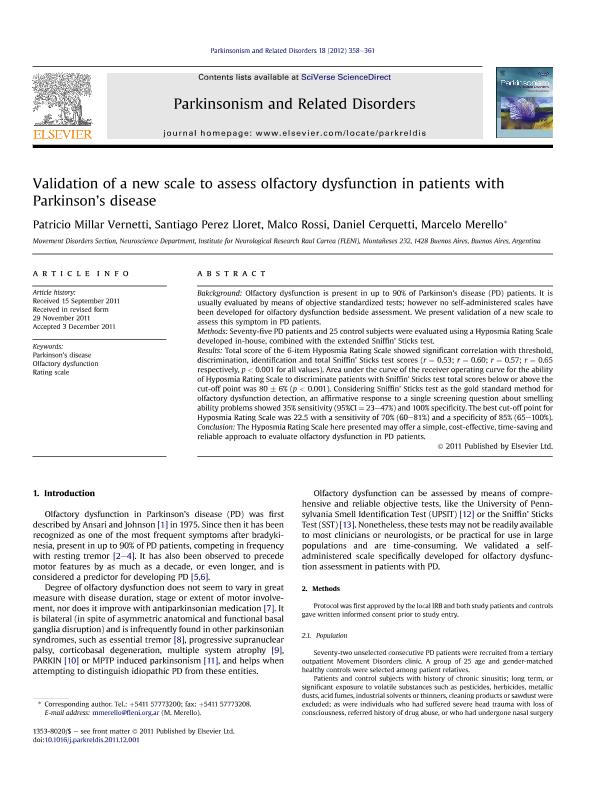Mostrar el registro sencillo del ítem
dc.contributor.author
Millar Vernetti, Patricio Alejandro

dc.contributor.author
Perez Lloret, Santiago

dc.contributor.author
Rossi, Malco Damian

dc.contributor.author
Cerquetti, Daniel
dc.contributor.author
Merello, Marcelo Jorge

dc.date.available
2023-03-16T11:48:12Z
dc.date.issued
2012-05
dc.identifier.citation
Millar Vernetti, Patricio Alejandro; Perez Lloret, Santiago; Rossi, Malco Damian; Cerquetti, Daniel; Merello, Marcelo Jorge; Validation of a new scale to assess olfactory dysfunction in patients with Parkinson´s Disease; Elsevier; Parkinsonism & Related Disorders; 18; 4; 5-2012; 358-361
dc.identifier.issn
1353-8020
dc.identifier.uri
http://hdl.handle.net/11336/190715
dc.description.abstract
Bakckground: Olfactory dysfunction is present in up to 90% of Parkinson's disease (PD) patients. It is usually evaluated by means of objective standardized tests; however no self-administered scales have been developed for olfactory dysfunction bedside assessment. We present validation of a new scale to assess this symptom in PD patients. Methods: Seventy-five PD patients and 25 control subjects were evaluated using a Hyposmia Rating Scale developed in-house, combined with the extended Sniffin' Sticks test. Results: Total score of the 6-item Hyposmia Rating Scale showed significant correlation with threshold, discrimination, identification and total Sniffin' Sticks test scores (r = 0.53; r = 0.60; r = 0.57; r = 0.65 respectively, p < 0.001 for all values). Area under the curve of the receiver operating curve for the ability of Hyposmia Rating Scale to discriminate patients with Sniffin' Sticks test total scores below or above the cut-off point was 80 ± 6% (p < 0.001). Considering Sniffin' Sticks test as the gold standard method for olfactory dysfunction detection, an affirmative response to a single screening question about smelling ability problems showed 35% sensitivity (95%CI = 23-47%) and 100% specificity. The best cut-off point for Hyposmia Rating Scale was 22.5 with a sensitivity of 70% (60-81%) and a specificity of 85% (65-100%). Conclusion: The Hyposmia Rating Scale here presented may offer a simple, cost-effective, time-saving and reliable approach to evaluate olfactory dysfunction in PD patients.
dc.format
application/pdf
dc.language.iso
eng
dc.publisher
Elsevier

dc.rights
info:eu-repo/semantics/openAccess
dc.rights.uri
https://creativecommons.org/licenses/by-nc-sa/2.5/ar/
dc.subject
OLFACTORY DYSFUNCTION
dc.subject
PARKINSON'S DISEASE
dc.subject
RATING SCALE
dc.subject.classification
Neurología Clínica

dc.subject.classification
Medicina Clínica

dc.subject.classification
CIENCIAS MÉDICAS Y DE LA SALUD

dc.title
Validation of a new scale to assess olfactory dysfunction in patients with Parkinson´s Disease
dc.type
info:eu-repo/semantics/article
dc.type
info:ar-repo/semantics/artículo
dc.type
info:eu-repo/semantics/publishedVersion
dc.date.updated
2023-03-07T11:24:12Z
dc.journal.volume
18
dc.journal.number
4
dc.journal.pagination
358-361
dc.journal.pais
Países Bajos

dc.journal.ciudad
Amsterdam
dc.description.fil
Fil: Millar Vernetti, Patricio Alejandro. Fundación para la Lucha contra las Enfermedades Neurológicas de la Infancia; Argentina
dc.description.fil
Fil: Perez Lloret, Santiago. Fundación para la Lucha contra las Enfermedades Neurológicas de la Infancia; Argentina. Consejo Nacional de Investigaciones Científicas y Técnicas; Argentina
dc.description.fil
Fil: Rossi, Malco Damian. Fundación para la Lucha contra las Enfermedades Neurológicas de la Infancia; Argentina. Consejo Nacional de Investigaciones Científicas y Técnicas; Argentina
dc.description.fil
Fil: Cerquetti, Daniel. Fundación para la Lucha contra las Enfermedades Neurológicas de la Infancia; Argentina
dc.description.fil
Fil: Merello, Marcelo Jorge. Fundación para la Lucha contra las Enfermedades Neurológicas de la Infancia; Argentina. Consejo Nacional de Investigaciones Científicas y Técnicas; Argentina
dc.journal.title
Parkinsonism & Related Disorders

dc.relation.alternativeid
info:eu-repo/semantics/altIdentifier/url/https://www.sciencedirect.com/science/article/pii/S1353802011004263
dc.relation.alternativeid
info:eu-repo/semantics/altIdentifier/doi/http://dx.doi.org/10.1016/j.parkreldis.2011.12.001
Archivos asociados
